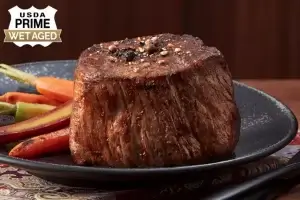Wagyu beef, which covers all kinds of Japanese cattle – including the famous “Kobe” variety – is one of the most demanded kinds of beef in the world. Authentic Wagyu is unquestionably some of the best beef in the world, with a distinct, buttery texture and flavor not found in other kinds of cattle.
Unfortunately, the terms “Wagyu” and “Kobe” are often deliberately misused by shady restaurants and sellers in an attempt to cheat their customers. This was famously exemplified from 2009 to 2012, when many restaurants served what they claimed was “authentic Kobe beef.” At the time, a USDA ban meant that authentic Kobe beef – which can only be raised in Japan – was nowhere to be found in America.
How To Buy Wagyu & Kobe Beef (Without Getting Cheated)
The kinds of underhanded practices outlined above shouldn’t stop you from buying Wagyu/Kobe. Instead, when purchasing Wagyu, Kobe, or Kobe-style beef, you should make sure you know what you’re buying with this essential buyer’s guide. In this guide, we teach you the terms you need to know and the questions you need to ask to make sure you’re getting the genuine article when it comes to Wagyu, Kobe, and Kobe-style beef.
The Terms You Need To Know When Buying Wagyu & Kobe Steaks
Before buying Wagyu, Kobe, or Kobe-Style beef, it’s essential you make sure you’re familiar with what makes each of these types of beef distinct.
Wagyu: Translates to “Japanese Cattle.” Wagyu refers to any of four distinctly Japanese breeds of cattle: Japanese Black, Japanese Brown/Red, Japanese Shorthorn, and Japanese Polled. Over 90% of all Wagyu are varieties of Japanese Black.
Kobe: Perhaps the most revered beef in the world. Also highly rare. Named after Kobe, the capital city of Hyogo Prefecture, the only place in the world where authentic Kobe beef can come from.
Tamija-Gyu: A strain of Japanese Black cattle. The most highly sought varieties of Wagyu beef come from Tamija cattle, including those from Matsusaka, Omi, and Kobe.
Domestic Wagyu:A term given to cattle that are genetically Wagyu, but exported and raised in countries like America and Australia. Domestic Wagyu are raised and bred under strict, controlled conditions to ensure Wagyu quality.
Kobe-Style: Refers to beef from Wagyu or Domestic Wagyu cattle whose beef matches Kobe standards, but was not born, raised, and/or butchered within Hyogo Prefecture.
Percentage Wagyu:A term given to cattle produced by crossbreeding Wagyu with other breeds and strains. These cattle are not true Wagyu, but are often marketed as such.
BMS: The Beef Marbling Standard is the marbling rating system used by Hyogo Prefecture. Kobe beef (and thus true Kobe-style beef) must have a rating of 6 or higher on a 12-point scale.
What You Need To Look For When Buying Wagyu & Kobe
When you’re looking for authentic Wagyu, Kobe, or Kobe-style beef, knowing what to look for and what questions to ask gives you an edge. Servers or sellers who abuse “Kobe” and “Wagyu” labels often do so without really knowing what those labels mean. Use the following guidelines to ensure your steak is authentic Kobe, Kobe-style, and/or Wagyu.
When Buying Beef Labelled “Kobe”
The bad news? The beef you’re looking at is almost definitely not real Kobe. Only 3,000 cattle a year qualify as true Kobe, making authentic Kobe beef exceptionally rare. Because the “Kobe” label is only trademarked within Japan, it is often misused by American sellers. The good news? Some Kobe does make it to the American market – and savvy buyers know the questions to ask to make sure it’s authentic.
What to look for:Anybody selling or serving Kobe should be deeply familiar with what sets Kobe beef apart (and at $200 per portion, they’d better). Ask if they know where the steak they are serving you was sourced from (correct answer: Hyogo Prefecture), what strain of cattle it comes from (correct answer: Tajima), and what its BMS rating is (correct answer: between 6-12). If they don’t know the answers, chances are the steak isn’t real Kobe.
When Buying Beef Labelled “Kobe-Style”
The label “Kobe-style” is reserved for Wagyu beef that has been raised to all Kobe beef standards except for those that require the cattle to have been born, fed, and slaughtered within Hyogo Prefecture. Scamming is less common with the “Kobe-style” label than it is with “Kobe,” but can still occur. You should know the Kobe standards before buying Kobe-style beef and should make sure your seller/server is knowledgeable about what “Kobe-style” means.
What to look for: Kobe-style beef only comes from 100% Tajima-Gyu beef, and should have a BMS rating between 6-12. Check to make sure your seller’s sources practice controlled breeding standards and rate marbling using Kobe-style methods.
When Buying Beef Labelled “Wagyu”
Wagyu beef is sourced from one of four breeds of Japanese cattle (Japanese Black, Japanese Brown/Red, Japanese Shorthorn, Japanese Polled). The Wagyu label can be used for either Japanese-raised Wagyu or Domestic Wagyu, i.e. Wagyu raised in America.
What to look for: If buying Domestic Wagyu, make sure that you’re buying from a reputable seller who sources beef from breeders who ensure pure bloodlines through controlled breeding. Otherwise, you risk buying “Percentage Wagyu,” i.e. Wagyu that’s been crossbred with American or European breeds
When Buying Beef Labelled “Wagyu-Style”
The “Wagyu-Style” label is – unfortunately – meaningless. Since Wagyu beef comes only from certain breeds of cattle, there is no style of breeding, feeding, raising, slaughter, or butchery that can make a non-Wagyu steak “Wagyu-style.” Cattle are either genetically Wagyu or they aren’t, period.
What to look for: A better restaurant, butcher, or meat market.
Learn More About Wagyu & Kobe
To find out more about Wagyu and Kobe and what makes them so highly prized, check out our guide to the differences between them.


